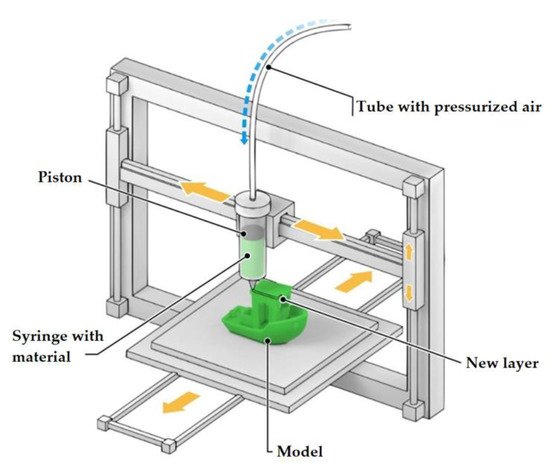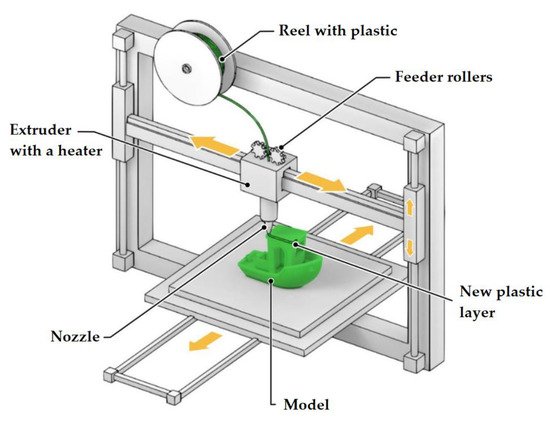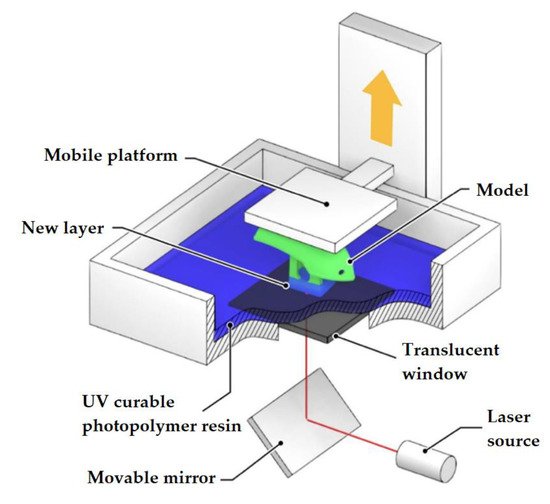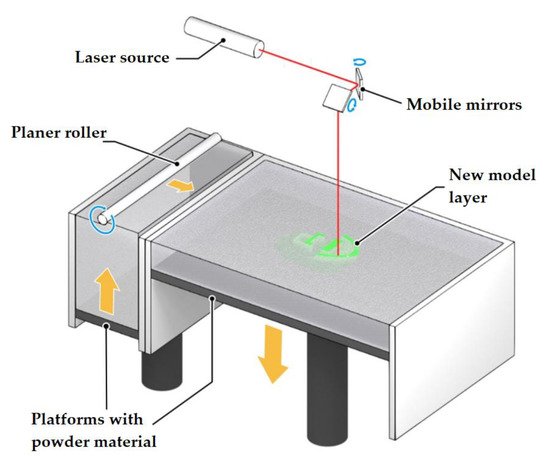
| Version | Summary | Created by | Modification | Content Size | Created at | Operation |
|---|---|---|---|---|---|---|
| 1 | Olga Kudryashova | + 2541 word(s) | 2541 | 2021-12-06 07:56:10 | | | |
| 2 | Vivi Li | Meta information modification | 2541 | 2021-12-08 02:53:35 | | |
Video Upload Options
In recent years, there has been explosive growth in interest toward additive manufacturing in many scientific research areas. This can be seen from the increase in the number of publications on this topic, as well as the respective economic indicators; the current additive manufacturing (AM) market size has already exceeded $1300 million. In practice, AM saves time and costs from the design stage to production. Additive manufacturing technologies have been developing for over 30 years. While at the onset, they consisted of relatively simple 3D printing of polymer prototypes, now it is possible to use AM to obtain metallic or non-metallic prototypes or functional products that do not require mechanical post-processing.
1. Introduction
2. High-Energy Composite Additive Manufacturing Technologies
2.1. Material Extrusion


2.2. Fused Deposition Modeling (FDM)

2.3. Photopolymerization (Laser Stereolithography (SLA), Digital Light Processing (DPL))


- -
-
All the components must be chemically compatible.
- -
-
The viscosity of the material should be sufficiently low, preferably below 20 Pa⋅s [43].
- -
-
The material must be sufficiently stable over time, i.e., sedimentation must not occur for several hours.
- -
-
The material must be sensitive to the wavelength range of the light source used.
- -
-
The material must be promptly cured, preferably within a few seconds.
- -
-
Light penetration into the material (including light scattering) must be limited to provide sufficient resolution in all directions.
- -
-
Once illuminated, the material must have sufficient mechanical strength to withstand transportation, treatment and use.
- -
-
The energy resin must not decompose when exposed to the light source used for curing.
- -
-
The energy properties (e.g., heat of explosion, combustion rate, detonation velocity) must be sufficient for the intended use.
2.4. Powder Printing (Binder Jetting, Powder Bed Printing)

2.5. Powder Sintering Technology (Selective Laser Sintering, SLS)

References
- Sreehitha, V. Impact of 3D printing in the automotive industry. Int. J. Mech. Prod. Eng. 2017, 5, 91–94.
- Liu, G.; Zhang, X.; Chen, X.; He, Y.; Cheng, L.; Huo, M.; Yin, J.; Hao, F.; Chen, S.; Wang, P.; et al. Additive manufacturing of structural materials. Mater. Sci. Eng. R Rep. 2021, 145, 100596.
- Lee, R.J.; Mock, W., Jr.; Carney, J.R.; Holt, W.H.; Pangilinan, G.I.; Gamache, R.M.; Boteler, J.M.; Bohl, D.G.; Drotar, J.; Lawrence, G.W. Reactive materials studies. AIP Conf. Proc. 2006, 845, 169–174.
- Hastings, D.L.; Dreizin, E.L. Reactive structural materials: Preparation and characterization. Adv. Eng. Mater. 2018, 20, 1700631.
- Pantoya, M.L.; Son, S.F.; Danen, W.C.; Jorgensen, B.S.; Asay, B.W.; Busse, J.R.; Mang, J.T. Characterization of Metastable Intermolecular Composites; ACS Symposium Series; American Chemical Society: Washington, DC, USA, 2005.
- Elbasuney, S.; Hamed, A.; Ismael, S.; Mokhtar, M.; Gobara, M. Novel high energy density material based on metastable intermolecular nanocomposite. J. Inorg. Organomet. Polym. Mater. 2020, 30, 3980–3988.
- Koch, E.C. Metal-Fluorocarbon Based Energetic Materials; John Wiley & Sons: Hoboken, NJ, USA, 2012.
- Hahma, A. Thermomechanical combustion enhancer and the effect of combustion catalysis on the burn rate and infrared radiation of magnesium-fluorocarbon-viton pyrolants. Int. J. Energetic Mater. Chem. Propuls. 2020, 19, 341–373.
- Stec, D., III; Wilson, A.; Fuchs, B.E.; Mehta, N.; Cook, P. High Explosive Fills for MEMS Devices. U.S. Patent No. 8,636,861, 28 January 2014.
- Muravyev, N.V.; Monogarov, K.A.; Schaller, U.; Fomenkov, I.V.; Pivkina, A.N. Progress in additive manufacturing of energetic materials: Creating the reactive microstructures with high potential of applications. Propellants Explos. Pyrotech. 2019, 44, 941–969.
- Marsh, W.N.K. Coating Surfaces with Explosive or Pyrotechnic Compositions. UK Patent GB 2,049,651A, 1 December 1982.
- Berni, A.; Mennig, M.; Schmidt, H. Doctor Blade. In Sol-Gel Technologies for Glass Producers and Users; Springer: Boston, MA, USA, 2004; pp. 89–92.
- Clark, B.; McCollum, J.; Pantoya, M.L.; Heaps, R.J.; Daniels, M.A. Development of flexible, free-standing, thin films for additive manufacturing and localized energy generation. AIP Adv. 2015, 5, 087128.
- Clark, B.; Zhang, Z.; Christopher, G.; Pantoya, M.L. 3D processing and characterization of acrylonitrile butadiene styrene (ABS) energetic thin films. J. Mater. Sci. 2017, 52, 993–1004.
- Bello, M.N.; Williams, A.; Shancita, I.; Hoque, M.N.; Christopher, G.; Aquino, A.J.; Pantoya, M.L. Synthesis and characterization of polymeric films with stress-altered aluminum particle fillers. J. Mater. Sci. 2020, 55, 14229–14242.
- Stec, D., III; Cheng, G.; Fuchs, B.E.; Neha, M. Method for Producing and Using High Explosive Material. U.S. Patent 7,964,045 B1, 21 June 2011.
- Fuchs, B.E.; Zunino, J.L., III; Schmidt, D.P.; Stec, D., III; Petrock, A.M. Flexible Detonator Integrated with Directly Written Energetics. U.S. Patent 8,573,123 B1, 5 November 2013.
- Li, Q.; An, C.; Han, X.; Xu, C.; Song, C.; Ye, B.; Wu, B.; Wang, J. CL-20 based Explosive Ink of Emulsion Binder System for Direct Ink Writing. Propellants Explos. Pyrotech. 2018, 43, 533–537.
- Ye, B.Y.; Song, C.K.; Huang, H.; Li, Q.B.; An, C.W.; Wang, J.Y. Direct ink writing of 3D-Honeycombed CL-20 structures with low critical size. Def. Technol. 2020, 16, 588–595.
- Chiroli, M.; Ciszek, F.; Baschung, B. Additive Manufacturing of Energetic Materials. In Proceedings of the 29th Annual International Solid Freeform Fabrication Symposium—An Additive Manufacturing Conference, Austin, TX, USA, 13–15 August 2018; University of Texas at Austin: Austin, TX, USA, 2018; p. 1003.
- Zhou, X.; Mao, Y.; Zheng, D.; Zhong, L.; Wang, R.; Gao, B.; Wang, D. 3D printing of RDX-based aluminized high explosives with gradient structure, significantly altering the critical dimensions. J. Mater. Sci. 2021, 56, 9171–9182.
- Ruz-Nuglo, F.D.; Groven, L.J. 3D Printing and Development of Fluoropolymer Based Reactive Inks. Adv. Eng. Mater. 2018, 20, 1700390.
- Gunduz, I.E.; McClain, M.S.; Cattani, P.; Chiu, G.T.-C.; Rhoads, J.F.; Son, S.F. 3D printing of extremely viscous materials using ultrasonic vibrations. Addit. Manuf. 2018, 22, 98–103.
- Woods, H.; Boddorff, A.; Ewaldz, E.; Adams, Z.; Ketcham, M.; Jang, D.J.; Brettmann, B. Rheological considerations for binder development in direct ink writing of energetic materials. Propellants Explos. Pyrotech. 2020, 45, 26–35.
- Driel, C.V.; Straathof, M.; Lingen, J.V. Developments in Additive Manufacturing of Energetic Materials at TNO. In Proceedings of the 30th International Symposium on Ballistics, Long Beach, CA, USA, 11–15 September 2017.
- Zong, H.; Cong, Q.; Zhang, T.; Hao, Y.; Xiao, L.; Hao, G.; Jiang, W. Simulation of Printer Nozzle for 3D Printing TNT/HMX Based Melt-Cast Explosive. Int. J. Adv. Manuf. Technol. 2021. preprint.
- Spence, T.R.; Williams, C.F. Energetic Thermoplastic Filaments for Additive Manufacturing and Methods for Their Fabrication. U.S. Patent 2018/0370119 A1, 27 December 2018.
- Li, L.; Lin, Q.; Tang, M.; Duncan, A.J.; Ke, C. Advanced polymer designs for direct-ink-write 3D printing. Chem. Eur. J. 2019, 25, 10768–10781.
- Knott, M.C.; Craig, A.W.; Shankar, R.; Morgan, S.E.; Iacono, S.T.; Mates, J.E.; McCollum, J.M. Balancing processing ease with combustion performance in aluminum/PVDF energetic filaments. J. Mater. Res. 2021, 36, 203–210.
- Fleck, T.J.; Murray, A.K.; Gunduz, I.E.; Son, S.F.; Chiu, G.T.-C.; Rhoads, J.F. Additive manufacturing of multifunctional reactive materials. Addit. Manuf. 2017, 17, 176–182.
- Collard, D.N.; Fleck, T.J.; Rhoads, J.F.; Son, S.F. Tailoring the reactivity of printable Al/PVDF filament. Combust. Flame 2021, 223, 110–117.
- Rehwoldt, M.C.; Wang, H.; Kline, D.J.; Wu, T.; Eckman, N.; Wang, P.; Zachariah, M.R. Ignition and combustion analysis of direct write fabricated aluminum/metal oxide/PVDF films. Combust. Flame 2020, 211, 260–269.
- Huang, S.; Hong, S.; Su, Y.; Jiang, Y.; Fukushima, S.; Gill, T.M.; Zheng, X. Enhancing combustion performance of nano-Al/PVDF composites with β-PVDF. Combust. Flame 2020, 219, 467–477.
- Ruiz-Morales, J.C.; Tarancón, A.; Canales-Vázquez, J.; Méndez-Ramos, J.; Hernández-Afonso, L.; Acosta-Mora, P.; Fernández-González, R. Three dimensional printing of components and functional devices for energy and environmental applications. Energy Environ. Sci. 2017, 10, 846–859.
- Fuller, J.; Ehrlich, D.; Lu, P.; Jansen, R.; Hoffman, J. Advantages of Rapid Prototyping for Hybrid Rocket Motor Fuel Grain Fabrication. In Proceedings of the 47th AIAA/ASME/SAE/ASEE Joint Propulsion Conference & Exhibit, San Diego, CA, USA, 31 July–3 August 2011; American Institute of Aeronautics and Astronautics: Resto, VA, USA, 2011; p. 1.
- Straathof, M.; van Lingen, J.N.; Driel, C.V.; den Otter, A. 3D Printing of Gun Propellants. In Proceedings of the 43th International Pyrotechnics Seminar, Fort Collins, CO, USA, 8–13 July 2018; IPSUSA Seminars Inc.: Littleton, CO, USA, 2018; p. 129.
- Cattani, P.A.; Fleck, T.J.; Rhoads, J.F.; Son, S.F.; Gunduz, I.E. Applications of Additive Manufacturing Techniques in Making Energetic Materials. In Proceedings of the Summer Undergraduate Research Fellowship (SURF) Symposium, West Lafayette, IN, USA, 4 August 2016; Purdue University: West Lafayette, IN, USA, 2016; p. 1.
- Yang, W.; Hu, R.; Zheng, L.; Yan, G.; Yan, W. Fabrication and investigation of 3D-printed gun propellants. Mater. Des. 2020, 192, 108761.
- Dolman, B.; Hart, A.; Johnston, I.; Prior, C. Advanced Munitions: 3D Printed Firepower. In Proceedings of the International Conference on Science and Innovation for Land Power 2018 (ICSILP 2018), Adelaide, SA, Australia, 5–6 September 2018; DST Group: Canberra, ACT, Australia, 2018; p. 1.
- Straathof, M.H.; van Driel, C.A.; van Lingen, J.N.; Ingenhut, B.L.; ten Cate, A.T.; Maalderink, H.H. Development of Propellant Compositions for Vat Photopolymerization Additive Manufacturing. Propellants Explos. Pyrotech. 2020, 45, 36–52.
- McClain, M.S.; Gunduz, I.E.; Son, S.F. Additive manufacturing of ammonium perchlorate composite propellant with high solids loadings. Proc. Combust. Inst. 2019, 37, 3135–3142.
- Faes, M.; Valkenaers, H.; Vogeler, F.; Vleugels, J.; Ferraris, E. Extrusion-based 3D Printing of Ceramic Components. Procedia CIRP 2015, 28, 76–81.
- Pfaffinger, M.; Hartmann, M.; Schwentenwein, M.; Stampfl, J. Stabilization of Tricalcium Phosphate Slurries Against Sedimentation for Stereolithographic Additive Manufacturing and Influence on the Final Mechanical Properties. Int. J. Appl. Ceram. Technol. 2017, 14, 499–506.
- Bukovsky, E.V.; Reeves, R.V.; Krish, A.; Gash, A.E.; Glumac, N.G. Experimental study of structure/behavior relationship for a metallized explosive. AIP Conf. Proc. 2018, 1979, 150006.
- Bakshi, K.R.; Mulay, A.V. A review on selective laser sintering: A rapid prototyping technology. IOSR J. Mech. Civ. Eng. 2016, 5, 53–57.
- Jiba, Z.; Focke, W.W.; Kalombo, L.; Madito, M.J. Coating processes towards selective laser sintering of energetic material composites. Def. Technol. 2020, 16, 316–324.




